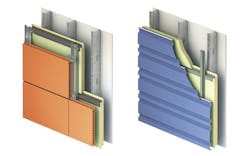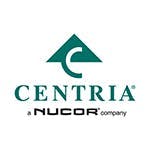Five Reasons to Choose an Insulated Composite Backup Wall System
A pharmaceutical research center in an office park, a new middle school in a growing town, or a performing arts center in a big city. When designing an architectural building facade, the options are endless for a protective and aesthetic solution. But not all systems deliver the same performance and long-term durability provided by an insulated composite backup panel.
In the exterior cladding decision process, there are a lot of considerations, from timelines and cost to performance and installation requirements. Here are five reasons to specify an insulated composite backup panel system:
1. Ease of installation.
With integrated panel joinery and one component panel, an insulated composite backup panel system can be installed in one step around a building. Rather than multiple trades coming on different days to install the multiple components of a traditional construction building envelope, one crew can install the panels and complete the wall in one step.
In regions with higher labor costs such as the Northeast or the West Coast, backup wall panels save additional money on construction by shortening the installation time and requiring less people for installation.
2. Ability to button up a building faster.
As construction demand continues to rise, efficiency on the job site is critical to meet project schedules. Easy installation of the insulated composite backup panel system translates to enclosing the building faster. This means the building can be closed in from the elements for the winter faster and interior construction can continue through the winter months. In the spring, rainscreen facade materials can be mounted to the backup wall to provide the aesthetic details desired.
3. Same manufacturer for the insulated composite backup panel and rainscreen.
An insulated composite backup panel system replaces the multiple component wall assembly approach in traditional construction that includes exterior gypsum, air and vapor barrier, rigid insulation and rainscreen. The insulated composite backup panel provides a five-in-one design combining exterior finish, air, vapor, water, and thermal barriers in one assembly. A metal, aluminum, terra cotta, or brick rainscreen is then mounted onto the insulated composite backup panel. Having a single source supplier for the insulated composite backup panel and rainscreen delivers a weather tight and warrantied system.
4. Single source of responsibility if there is a failure in the system.
With traditional construction, the multiple components needed to complete the exterior walls are delivered from multiple manufacturers. Each of those products then needs to be installed by a different trade on a different day. This complicates the construction schedule and creates multiple points of potential failure in the cladding system. With an insulated composite backup panel there is one product and one installer, substantially reducing the potential for failure and delivering a fully sealed system.
5. Consistent protection and design flexibility.
An insulated composite backup panel is installed around the entire building, ensuring the entire building is weatherized. At the same time, the insulated composite backup panel allows for different aesthetic rainscreen product to be attached to the exterior without impacting the protective barrier of the building. In this way, architects can adjust the design and add features to certain areas based on the design vision they seek to fulfill.
Make the Change
Insulated composite backup panel systems provide air, vapor, thermal, and moisture protection in a one-step installation, with the added benefit of design versatility. With quicker close-in and a single source supplier, the benefits of an insulated composite backup panel system mean cost savings on the project, time savings on installation, and a building that meets the design and performance requirements of the owner.
SOCIAL MEDIA:
Facebook: https://www.facebook.com/CENTRIAperformance
Twitter: https://twitter.com/CENTRIA
Instagram: https://www.instagram.com/centriaperformance/
LinkedIn: https://www.linkedin.com/company/centria
About the Author

Eric Jenkins, CENTRIA
Eric Jenkins is a business development manager at CENTRIA with an expertise in the architectural and construction industries.

